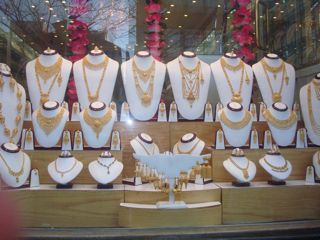From The Peopling of New York City
Mango Lassi Ice-creamLiving in Queens for the past 5 years, I’ve never considered Jackson Heights as a subject of study. This weekend’s class visit, however, gave me a surface view of this neighborhood through a different perspective. Jackson Heights was always the place to go for delicious mango lassi ice cream, but the multiple block span of this ethnic community presents much more than good sweets. The economic life in this neighborhood shows a surplus of ethnically centered goods. Ubiquitous items such as
saris, yellow gold, and Bhangra CDs, make this area easily distinguishable from the neighboring Spanish and Asian clusters of Queens. I noticed that markets sell produce and spices targeting Indian cuisine, and services, such as palmistry, targeting the Indian-American population. This feature, of an ethnic community catering to the needs of co-ethnics, carries over to any other ethnic community in New York City. Walking the streets, I couldn't help compare Jackson Heights with Greenpoint, Brooklyn, the mainly Polish community I grew up in, and Flushing Queens, the largely Chinese area I spent much time around. Although all three communities are changing at a steady rate, they still house a population of first generation immigrants who find comfort in the presence of co-ethnic neighbors, supermarkets, and cultural events.
While the Polish neighborhood of Greenpoint feels like home to me because of my Polish background, Jackson Heights continues to hold a sense of exoticism in my eyes. From the unfamiliar vegetables, to the sparkly wedding attire, it is always interesting to explore another culture interactively. The sense of “community” in Jackson Heights is visible through the publication of neighborhood newspapers, and Indian-American networks that aid new immigrants through housing, work, and their general establishment.
Walking around, it came to my attention for the first time that this neighborhood is not only home to Hindus from India, but also to Muslims from Bangladesh and Pakistan. This conflict of religion reflects the juxtaposition of Ganesh statues in jewelry store windows, and Qu-ran texts sold on tables lining the sidewalks. Although the presence of Hindu deity and tradition dominates the streets, walking around, I saw various reminders of an Islamic belief system and culture present among the Jackson Heights population.
An interesting observation that I could not overlook was the overpowering depiction of the “perfect woman” as represented by many Jackson Heights industries. The jewelry, film, and music businesses, in specific, displayed prominently slim, lighter-skinned woman, with young, innocent faces, and seductive eyes. Judgin by the advertisements, lighter eyes (blue or green), in particular, seem to be of exceptional value in South Asian culture. It seems as if there is a battle between conservatism/chastity and sex appeal in Bollywood productions, based on the films and posters. Additionally, the importance of gold and jewels in Indian culture, which mainly the women wear, places a strong emphasis on feminine sacredness, beauty, and delicacy.
Reflecting on my visit to Jackson Heights this weekend, it is safe to say that a first time visitor could be overwhelmed. As a person who walked those blocks before, however, it was interesting to look at the storefronts, active industries, and demographics, through a new perspective. Although the streets our class explored have maintained their feel, I undoubtedly noticed a decrease in the amount of Indian businesses closer to the subway. It seems as if the neighborhood is diminishing, and commercial chains are slowly replacing the areas closer to Roosevelt Avenue and 74th street. Although this dissolvement of South Asian businesses is unsettling, Jackson Heights manages maintains the character it is known for. I look forward to visiting Jackson Heights again, this time not only for the ice cream, but also for a deeper understanding of the multi-layered ethnic economy that is home to so many new Americans.


